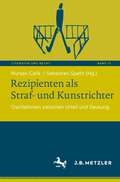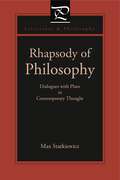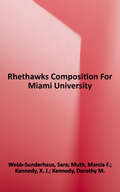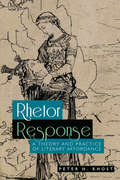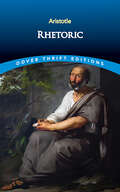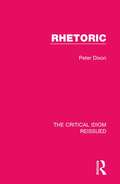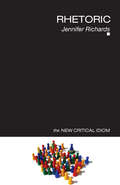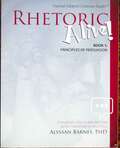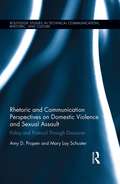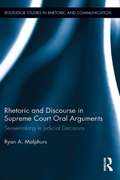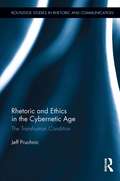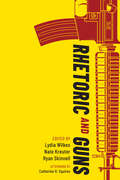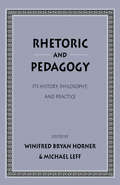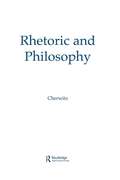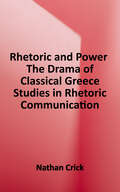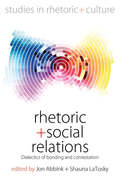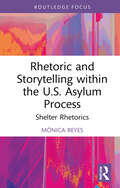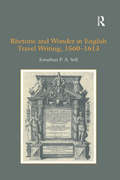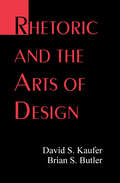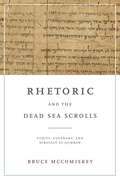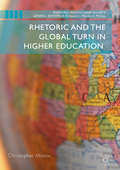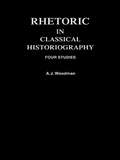- Table View
- List View
Rezipienten als Straf- und Kunstrichter: Oszillationen zwischen Urteil und Deutung (Literatur und Recht #11)
by Nursan Celik Sebastian SpethRechtsprechung steht unter dem Diktat der Urteilspflicht und muss Mehrdeutigkeit daher einhegen und urteilend auflösen. Literatur hält Formen und Prozesse von Mehrdeutigkeit dagegen ohne Schwierigkeit aus. Sie werden als Potenzierung der ästhetischen Qualität sogar gerühmt und forciert. Die Beiträge des vorliegenden Bandes sind Texten und Rezeptionszusammenhängen gewidmet, die Rezipientinnen und Rezipienten explizit in eine Richterposition setzen. Konkret geht es um literarische Phänomene, bei denen Rezipierende nicht bloß verstehen und deuten, sondern (be- und ver-)urteilen – zum einen im engen (juristischen) und zum anderen im weiten (ästhetischen) Sinne des Urteilsbegriffs. Zu unterscheiden sind hierbei Laienurteile in Strafsachen und die Einforderung professioneller Urteile, bei denen Leserinnen und Leser (metaphorisch) als Kunstrichter angesprochen, konstruiert oder zu agieren verpflichtet werden. Das literaturgeschichtliche Spektrum reicht dabei vom 18. Jahrhundert bis zur Gegenwart, mit einem Schwerpunkt im frühen 20. Jahrhundert.
Rhapsody of Philosophy: Dialogues with Plato in Contemporary Thought (Literature and Philosophy)
by Max StatkiewiczThis book proposes to rethink the relationship between philosophy and literature through an engagement with Plato’s dialogues. The dialogues have been seen as the source of a long tradition that subordinates poetry to philosophy, but they may also be approached as a medium for understanding how to overcome this opposition. Paradoxically, Plato then becomes an ally in the attempt “to overturn Platonism,” which Gilles Deleuze famously defined as the task of modern philosophy. Max Statkiewicz identifies a “rhapsodic mode” initiated by Plato in the dialogues and pursued by many of his modern European commentators, including Nietzsche, Heidegger, Irigaray, Derrida, and Nancy. The book articulates this rhapsodic mode as a way of entering into true dialogue (dia-logos), which splits any univocal meaning and opens up a serious play of signification both within and between texts. This mode, he asserts, employs a reading of Plato that is distinguished from interpretations emphasizing the dialogues as a form of dogmatic treatise, as well as from the dramatic interpretations that have been explored in recent Plato scholarship—both of which take for granted the modern notion of the subject. Statkiewicz emphasizes the importance of the dialogic nature of the rhapsodic mode in the play of philosophy and poetry, of Platonic and modern thought—and, indeed, of seriousness and play. This highly original study of Plato explores the inherent possibilities of Platonic thought to rebound upon itself and engender further dialogues.
Rhethawks: Composition For Miami University
by X. J. Kennedy Webb-Sunderhaus Sara Muth Marcia F. Kennedy Dorothy M.This book is part of a long lineage of student thoughtfulness and creativity. This volume is first and foremost a showcase for the voices of students who have come before you. You will also find advice and resources from Miami composition instructors. Your ideas and voices are what count the most in the writing classroom, and your instructors will help you express them with more effectiveness.
Rhetor Response: A Theory and Practice of Literary Affordance
by Peter H. KhostBridging the disciplinary divide between writing and literature, Rhetor Response introduces the concept and pedagogical applications of “literary affordances”—the ways in which readers “use” and integrate literature into their own writing or lives. Unconcerned with authorial intent, interpretive meaning, or critical reception, “affordance” signifies a shift in focus from what literary texts mean and do to what one can do with them. This book presents both opportunities and challenges to writing studies, a field whose burgeoning disciplinary independence ironically relies on a sizable underclass of specialists in literature rather than writing. Incorporating elements of rhetorical theory, literary criticism, pedagogical methodology, political critique, and psychological and philosophical memoir, Peter H. Khost complicates and revives the relevance of literature—from belles lettres to fanfiction—by turning from interpretation to affordance in order to identify readers’ applications of literary textual features to unrelated lived situations. Rhetor Response theorizes and exemplifies literary affordance as a constructive step toward professional reconciliation, as well as an entry into greater textual power and pleasure for students and readers. It is a one-of-a-kind resource for college writing program administrators, faculty and scholars in English and writing studies, and graduate and advanced undergraduate students across both disciplines.
Rhetoric (Dover Thrift Editions: Philosophy)
by AristotleOne of the seminal works of Western philosophy, Aristotle's Rhetoric vastly influenced all subsequent thought on the subject — philosophical, political, and literary. Focusing on the use of language as both a vehicle and a tool to shape persuasive argument, Aristotle delineates with remarkable insight both practical and aesthetic elements and their proper combination in an effective presentation, oral or written. He also emphasizes the role of language in achieving precision and clarity of thought.The ancients regarded rhetoric as the crowning intellectual discipline — the synthesis of logical principles and other knowledge attained from years of schooling. Modern readers will find considerable relevance in Aristotelian rhetoric and its focus on developing persuasive tools of argumentation. Aristotle's examinations of how to compose and interpret speeches offer significant insights into the language and style of contemporary communications, from advertisements to news reports and other media.
Rhetoric (The Critical Idiom Reissued #18)
by Peter DixonFirst published in 1971, this book provides a historical account of the fortunes of Rhetoric. Beginning with a study of classical rhetorical theory and practice, it goes on to explore the impact of rhetoric on English literature and the renunciation of rhetoric from the late 17th century. The book concludes with a survey of the ways in which rhetoric was revived and re-modelled in the 20th century and its bearings on the practice and theory of literary criticism. This book will be of interest to those studying English literature and literary theory.
Rhetoric (The New Critical Idiom)
by Jennifer RichardsRhetoric has shaped our understanding of the nature of language and the purpose of literature for over two millennia. It is of crucial importance in understanding the development of literary history as well as elements of philosophy, politics and culture. The nature and practise of rhetoric was central to Classical, Renaissance and Enlightenment cultures and its relevance continues in our own postmodern world to inspire further debate.Examining both the practice and theory of this controversial concept, Jennifer Richards explores: historical and contemporary definitions of the term ‘rhetoric’ uses of rhetoric in literature, by authors such as William Shakespeare, Mary Shelley, William Wordsworth, Jane Austen, W.B. Yeats and James Joyce classical traditions of rhetoric, as seen in the work of Plato, Aristotle and Cicero the rebirth of rhetoric in the Renaissance and the Enlightenment the current status and future of rhetoric in literary and critical theory as envisaged by critics such as Kenneth Burke, Paul de Man and Jacques Derrida. This insightful volume offers an accessible account of this contentious yet unavoidable term, making this book invaluable reading for students of literature, philosophy and cultural studies.
Rhetoric Alive! Book 1: Principles of Persuasion
by Alyssan BarnesA one-semester or yearlong course for students in grades 10-12. Rhetoric Alive! Book 1: Principles of Persuasion, written by Alyssan Barnes, an experienced rhetoric teacher with a PhD in rhetoric, is a clear, compelling, and delightful text on rhetorical theory and practice. The highly engaging Rhetoric Alive! explores the principles of winsome speech as developed in the foremost text on persuasion, Aristotle's Rhetoric. The fifteen chapters of Rhetoric Alive! step through the essential components of persuasion: the three appeals; Ethos (speaker's credibility), Pathos (audience's emotion), and Logos (argument's reasoning), the three types of speech; Deliberative (exhort or dissuade), Ceremonial (praise or blame), Judicial (accuse or defend), and the five canons; Invention, Organization, Style, Memory, Delivery. Each chapter includes an exemplary classic text for analysis and discussion, spanning from Pericles's 'Funeral Oration' to Martin Luther King, Jr.'s, 'Letter from Birmingham Jail.' Students also have plenty of practice developing their own rhetorical skill through weekly workshops, imitation assignments, and oratory presentations.
Rhetoric and Communication Perspectives on Domestic Violence and Sexual Assault: Policy and Protocol Through Discourse (Routledge Studies in Technical Communication, Rhetoric, and Culture)
by Amy D. Propen Mary SchusterThis book brings rhetorical, legal, and professional communication perspectives to the discourse surrounding policy-making efforts within the United States around two types of violent crimes against women: domestic violence and sexual assault. The authors propose that such analysis adds to our understanding of rhetorical concepts such as kairos, risk perception, moral panic, genre analysis, and identity theory. Overall, the goal is to demonstrate how rhetorical, legal, and professional communication perspectives work together to illuminate public discourse and conflict in such complicated and ongoing dilemmas as how to aid victims of domestic violence and sexual assault, and how to manage the offenders of such crimes—social and cultural problems that continue to perplex the legal system and the social environment.
Rhetoric and Composition
by Steven LynnRhetoric and composition is an academic discipline that informs all other fields in teaching students how to communicate their ideas and construct their arguments. It has grown dramatically to become a cornerstone of many undergraduate courses and curricula, and it is a particularly dynamic field for scholarly research. This book offers an accessible introduction to teaching and studying rhetoric and composition. By combining the history of rhetoric, explorations of its underlying theories, and a survey of current research (with practical examples and advice), Steven Lynn offers a solid foundation for further study in the field. Readers will find useful information on how students have been taught to invent and organize materials, to express themselves correctly and effectively, and how the ancient study of memory and delivery illuminates discourse and pedagogy today. This concise book thus provides a starting point for learning about the discipline that engages writing, thinking, and argument.
Rhetoric and Discourse in Supreme Court Oral Arguments: Sensemaking in Judicial Decisions (Routledge Studies in Rhetoric and Communication)
by Ryan MalphursWhile legal scholars, psychologists, and political scientists commonly voice their skepticism over the influence oral arguments have on the Court’s voting pattern, this book offers a contrarian position focused on close scrutiny of the justices’ communication within oral arguments. Malphurs examines the rhetoric, discourse, and subsequent decision-making within the oral arguments for significant Supreme Court cases, visiting their potential power and danger and revealing the rich dynamic nature of the justices’ interactions among themselves and the advocates. In addition to offering advancements in scholars’ understanding of oral arguments, this study introduces Sensemaking as an alternative to rational decision-making in Supreme Court arguments, suggesting a new model of judicial decision-making to account for the communication within oral arguments that underscores a glaring irony surrounding the bulk of related research—the willingness of scholars to criticize oral arguments but their unwillingness to study this communication. With the growing accessibility of the Court’s oral arguments and the inevitable introduction of television cameras in the courtroom, this book offers new theoretical and methodological perspectives at a time when scholars across the fields of communication, law, psychology, and political science will direct even greater attention and scrutiny toward the Supreme Court.
Rhetoric and Ethics in the Cybernetic Age: The Transhuman Condition (Routledge Studies in Rhetoric and Communication #17)
by Jeff PruchnicIt has become increasingly difficult to ignore the ways that the centrality of new media and technologies — from the global networking of information systems and social media to new possibilities for altering human genetics — seem to make obsolete our traditional ways of thinking about ethics and persuasive communication inherited from earlier humanist paradigms. This book argues that rather than devoting our critical energies towards critiquing humanist touchstones, we should instead examine the ways in which media and technologies have always worked as crucial cultural forces in shaping ethics and rhetoric. Pruchnic combines this historical itinerary with critical interrogations of diverse cultural and technological sites — the logic of video games and artificial intelligence, the ethics of life extension in contemporary medicine, the transition to computer-automated trading in world stock markets, the state of critical theory in the contemporary humanities — along with innovative analyses of the works of such figures as the Greek Sophists, Kenneth Burke, Martin Heidegger, Michel Foucault, Friedrich Nietzsche, and Gilles Deleuze. This book argues that our best strategies for crafting persuasive communication and producing ethical relations between individuals will be those that creatively replicate and appropriate, rather than resist, the logics of dominant forms of media and technology.
Rhetoric and Guns
by Ryan Skinnell Lydia Wilkes Nate KreuterGuns hold a complex place in American culture. Over 30,000 Americans die each year from gun violence, and guns are intimately connected to issues of public health, as is evident whenever a mass shooting occurs. But guns also play an important role in many Americans’ lives that is not reducible to violence and death—as tools, sporting equipment, and identity markers. They are also central to debates about constitutional rights, as seen in ongoing discussions about the Second Amendment, and they are a continuous source of legislative concern, as apparent in annual ratings of gun-supporting legislators. Even as guns are wrapped up with other crucial areas of concern, they are also fundamentally a rhetorical concern. Guns and gun violence occupy a unique rhetorical space in the United States, one characterized by silent majorities, like most gun owners; vocal minorities, like the firearm industry and gun lobby; and a stalemate that fails to stem the flood of the dead. How Americans talk, deliberate, and fight about guns is vital to how guns are marketed, used, and regulated. A better understanding of the rhetorics of guns and gun violence can help Americans make better arguments about them in the world. However, where guns are concerned, rhetorical studies is not terribly different from American culture more generally. Guns are ever-present and exercise powerful effects, but they are commonly talked about in oblique, unsystematic ways. Rhetoric and Guns advances more direct, systematic engagement in the field and beyond by analyzing rhetoric about guns, guns in rhetoric, and guns as rhetoric, particularly as they relate to specific instances of guns in culture. The authors attempt to understand rhetoric’s relationship to guns by analyzing rhetoric about guns and how they function in and as rhetoric related to specific instances—in media coverage, political speech, marketing, and advertising. Original chapters from scholars in rhetorical studies, communication, education, and related fields elucidate how rhetoric is used to maintain and challenge the deadly status quo of gun violence in the United States and extend rhetoricians’ sustained interest in the fields’ relationships to violence, brutality, and atrocity. Contributors: Ira J. Allen, Brian Ballentine, Matthew Boedy, Peter Buck, Lisa Corrigan, Rosa Eberly, Kendall Gerdes, Ian E. J. Hill, Nathalie Kuriowa-Lewis, Patricia Roberts-Miller, Craig Rood, Bradley Serber, Catherine R. Squires, Scott Gage
Rhetoric and Pedagogy: Its History, Philosophy, and Practice: Essays in Honor of James J. Murphy (Rhetoric And Public Affairs Ser.)
by Winifred Bryan Horner Michael LeffTo provide a view of the history of western rhetoric, this volume presents original articles by a number of world-renowned scholars representing different countries and varying viewpoints. In discussing the status of the historical perspectives on rhetoric, these international scholars also present a tribute to James J. Murphy, whose scholarship and service did much to shape the field. The book will introduce new insights into western European rhetoric and its connections with English rhetoric.
Rhetoric and Philosophy
by Richard A. CherwitzThis important volume explores alternative ways in which those involved in the field of speech communication have attempted to find a philosophical grounding for rhetoric. Recognizing that rhetoric can be supported in a wide variety of ways, this text examines eight different philosophies of rhetoric: realism, relativism, rationalism, idealism, materialism, existentialism, deconstructionism, and pragmatism. The value of this book lies in its pluralistic and comparative approach to rhetorical theory. Although rhetoric may be the more difficult road to philosophy, the fact that it is being traversed by a group of authors largely from speech communication demonstrates important growth in this field. Ultimately, there is recognition that if different thinkers can have solid reasons to adhere to disparate philosophies, serious communication problems can be eliminated. Rhetoric and Philosophy will assist scholars in choosing from among the many philosphical starting places for rhetoric.
Rhetoric and Power: The Drama of Classical Greece (Studies in Rhetoric/Communication Series)
by Nathan CrickAn examination of how intellectuals and artists conceptualized rhetoric as a medium of power in a dynamic age of democracy and empire. <p><p> In Rhetoric and Power, Nathan Crick dramatizes the history of rhetoric by explaining its origin and development in classical Greece, beginning with the oral displays of Homeric eloquence in a time of kings, following its ascent to power during the age of Pericles and the Sophists, and ending with its transformation into a rational discipline with Aristotle in a time of literacy and empire. Crick advances the thesis that rhetoric is primarily a medium and artistry of power, but that the relationship between rhetoric and power at any point in time is a product of historical conditions, not the least of which is the development and availability of communication media. <p><p>Investigating major works by Homer, Heraclitus, Aeschylus, Protagoras, Gorgias, Thucydides, Aristophanes, Plato, Isocrates, and Aristotle, Rhetoric and Power tells the story of the rise and fall of classical Greece while simultaneously developing rhetorical theory from the close criticism of particular texts. As a form of rhetorical criticism, this volume offers challenging new readings to canonical works such as Aeschylus's Persians, Gorgias's Helen, Aristophanes's Birds, and Isocrates's Nicocles by reading them as reflections of the political culture of their time. Through this theoretical inquiry, Crick uses these criticisms to articulate and define a plurality of rhetorical genres and concepts, such as heroic eloquence, tragicomedy, representative publicity, ideology, and the public sphere, and their relationships to different structures and ethics of power, such as monarchy, democracy, aristocracy, and empire. <p><p>Rhetoric and Power thus provides a foundation for rhetorical history, criticism, and theory that draws on contemporary research to prove again the incredible richness of the classical tradition for contemporary rhetorical scholarship and practice.
Rhetoric and Social Relations: Dialectics of Bonding and Contestation (Studies in Rhetoric and Culture #8)
by Jon Abbink Shauna LaToskyThis volume explores the constitutive role of rhetoric in socio-cultural relations, where discursive persuasion is so important, and contains both theoretical chapters as well as fascinating examples of the ambiguities and effects of rhetoric used (un)consciously in social praxis. The elements of power, competition and political persuasion figure prominently. It is an accessible collection of studies, speaking to common issues and problems in social life, and shows the heuristic and often explanatory value of the rhetorical perspective.
Rhetoric and Storytelling within the U.S. Asylum Process: Shelter Rhetorics (Routledge Studies in Rhetoric and Communication)
by Mónica ReyesThis book explores the U.S. asylum process and how those seeking shelter deal with the rhetorical pressures of compelling asylum narratives they need to write in order to stay.Centered around a study conducted at a shelter on the U.S. border, this book moves beyond this context to demonstrate how liminal sites provide opportunities for displaced communities to employ distinct shared rhetorical practices of daily life—like silence and routine—that both safeguard vulnerabilities and enact agency for individuals within precarious spaces. Placing people who seek asylum and those who work with them as rhetorical and socio-cultural experts on this issue, the study adds to the emerging importance of rhetoric within discussions of asylum and forced migration and demonstrates the significance of rhetorical ecology theory as part of a blended methodology in understanding people seeking asylum as a group in a perpetual and explicit state of ethos development.Highlighting the need for support which is sensitive to the narrative struggles people seeking asylum face, this book will have important findings for scholars and upper-level students of cultural rhetorics, feminist rhetoric, migration studies, political science, and intercultural communication.
Rhetoric and Wonder in English Travel Writing, 1560-1613
by Jonathan P.A. SellRhetoric and Wonder in English Travel Writing, 1560-1613, shows how rhetorical invention, elocution and ethos combined to create plausible representations by generating intellectual and emotional significances which, meaningful in consensual terms, were 'consensually' true. However, some traveller-writers betrayed an unease with such representation, rooted as it was in a metaphorical epistemology out of kilter with an increasingly empiricist age. This book throws new light onto the episteme shift that ushered in modernity with its distrust of metaphor in particular and rhetoric's 'wordish descriptions' in general. In response to the empirical desiderata of scientific rationalism, traveller-writers textually or physically made their own bodies available as evidence of their encounters with wonder, thus transforming themselves into wonderful objects. The irony is that, far from dispensing with rhetoric, they merely put the accent on its more dramatic arts of gesture and action. The body's evidence could still be doctored, but its illusory truths were better able to satisfy the empirical demand for 'ocular proof'. The author's main purposes here are to complement, and sometimes counter, recent work on early modern travel literature by concentrating on its use of rhetoric to communicate meaning; and to suggest how familiarity with the workings of rhetoric and its communicative and epistemological premises may enhance readings of early modern English literature generally.
Rhetoric and the Arts of Design
by David S. Kaufer Brian S. ButlerThe design arts -- from the design of buildings and machines to software and interfaces -- are associated with types of knowledge and performance thought to be structured, modular, and systematic. Such arts have become increasingly prestigious in our technocratic society. Since Aristotle, the art of rhetoric was conceived as a loosely structured "practical" art thought to be limited in the extent to which it could mimic more precise subject matters. The art of rhetoric has been controversial since classical times, but its status has sunk even lower since the industrial revolution -- a point when civic cultures began to cede authority and control to the cultures of specialized experts. Many sympathizers of rhetoric have resisted its decline by calling for a civic art of public discourse to stand in opposition to a technocratic specialized discourse that has come, increasingly, to disenfranchise the ordinary citizen. This is the first book to question the rhetoric/technical knowledge split from a more fundamental perspective. To get some perspective on what is at stake in rhetoric's traditional classification as a "practical" art, the authors: * explore the distinction between practical and design arts; * enumerate the various criteria cited in the literature for qualifying a cluster of knowledge and performative skills to count as an art of design; * show how the knowledge and performative skills associated with the art of rhetoric meet the major requirements of design knowledge; * propose a general architecture of rhetorical design, one descriptive both of civic address and specialized academic argument; * turn to the Lincoln/Douglas debates to embody and provide some empirical support and illustration for their architecture; * demonstrate how Lincoln and Douglas can be thought of as expert designers whose rhetoric is highly structured and modular; and * explain how the rhetoric of both rhetorical agents can be represented in the layers and modules that one needs to display plans for buildings, software, or other design artifacts. These layers and modules are not just post hoc annotations of the debates; they also illuminate new and systematic ways for viewing the debates -- and by implication, other specimens of rhetoric -- in terms of strategies of artistic production. Kaufer and Butler conclude their presentation by citing some of the research and educational implications that follow from housing rhetoric within the family of design arts.
Rhetoric and the Dead Sea Scrolls: Purity, Covenant, and Strategy at Qumran
by Bruce McComiskeyDiscovered in 1947, the Dead Sea Scrolls are a collection of ancient Israelite documents, many of which were written by a Jewish sectarian community at Qumran living in self-exile from the priesthood of the Second Temple. This first book-length study of the rhetoric of these texts illustrates how the Essenes employed different rhetorics over time as they struggled to understand God’s word and their mission to their people, who seemed to have turned away from God and his purposes.Applying methods of rhetorical analysis to six substantive texts—Miqṣat Maʿaśeh ha-Torah, Rule of the Community, Damascus Document, Purification Rules, Temple Scroll, and Habakkuk Pesher—Bruce McComiskey traces the Essenes’ use of rhetorical strategies based on identification, dissociation, entitlement, and interpretation. Through his analysis, McComiskey uncovers a unique, fascinating story of an ancient religious community that had sought to reintegrate into Temple life but, dejected, instead established itself as the new covenant people of God for this world, only to turn ultimately to a trust in a metaphysical afterlife.Presenting forms of ancient Jewish rhetoric largely uninfluenced by classical rhetoric, this book broadens our understanding of human and religious rhetorical practice, even as it provides new insight into the events that led to the emergence of the Talmudic period. Rhetoric and the Dead Sea Scrolls will be useful to scholars working in the fields of religious rhetoric, Jewish studies, and early Christianity.
Rhetoric and the Dead Sea Scrolls: Purity, Covenant, and Strategy at Qumran
by Bruce McComiskeyDiscovered in 1947, the Dead Sea Scrolls are a collection of ancient Israelite documents, many of which were written by a Jewish sectarian community at Qumran living in self-exile from the priesthood of the Second Temple. This first book-length study of the rhetoric of these texts illustrates how the Essenes employed different rhetorics over time as they struggled to understand God’s word and their mission to their people, who seemed to have turned away from God and his purposes.Applying methods of rhetorical analysis to six substantive texts—Miqṣat Maʿaśeh ha-Torah, Rule of the Community, Damascus Document, Purification Rules, Temple Scroll, and Habakkuk Pesher—Bruce McComiskey traces the Essenes’ use of rhetorical strategies based on identification, dissociation, entitlement, and interpretation. Through his analysis, McComiskey uncovers a unique, fascinating story of an ancient religious community that had sought to reintegrate into Temple life but, dejected, instead established itself as the new covenant people of God for this world, only to turn ultimately to a trust in a metaphysical afterlife.Presenting forms of ancient Jewish rhetoric largely uninfluenced by classical rhetoric, this book broadens our understanding of human and religious rhetorical practice, even as it provides new insight into the events that led to the emergence of the Talmudic period. Rhetoric and the Dead Sea Scrolls will be useful to scholars working in the fields of religious rhetoric, Jewish studies, and early Christianity.
Rhetoric and the Global Turn in Higher Education (Rhetoric, Politics And Society Ser.)
by Christopher MinnixThis book studies the role of rhetoric in the expansive movement for global higher education in U.S. colleges and universities. Drawing on an analysis of how discourses of security, economy, and ethics shape the rhetoric of global higher education, as well as that of its populist and nationalist critics, the author argues for an understanding of global higher education as a site of rhetorical conflict over visions of students as citizens. In doing so, the work advances the project of transnational rhetorical education, a theoretical and pedagogical project that can foster forms of rhetorical inquiry, performance, and ethics that equip students to pursue transnational forms of civic engagement, belonging, and resistance. This book will be of interest to scholars and students in the fields of rhetoric and composition studies, communication, and education, as well as to faculty and administrators working in global higher education or internationalization programs.
Rhetoric in Classical Historiography: Four Studies
by A.J. WoodmanThis radical study argues against the view that the historian's craft has remained largely unchanged since classical times. Includes detailed discussion of the work of Thucydides, Cicero, Sallust, Livy and Tacitus.
Rhetoric in Debt (RSA Series in Transdisciplinary Rhetoric)
by Kellie Sharp-HoskinsIn recent years, household indebtedness in the United States reached its highest levels in history. From mortgages to student loans, from credit card bills to US deficit spending, debt is widespread and increasing.Drawing on scholarship from economics, accounting, and critical rhetoric and social theory, Kellie Sharp-Hoskins critiques debt not as an economic indicator or a tool of finance but as a cultural system. Through case studies of the student-loan crisis, medical debt, and the abuses of municipal bonds, Sharp-Hoskins reveals that debt is a rhetorical construct entangled in broader systems of wealth, rule, and race. Perhaps more than any other social marker or symbol, the concept of “debt” indicates differences between wealthy and poor, productive and lazy, secure and risky, worthy and unworthy. Tracking the emergence and work of debt across temporal and spatial scales reveals how it exacerbates vulnerabilities and inequities under the rhetorical cover of individual, moral, and volitional calculation and equivalency.A new perspective on a serious problem facing our society, Rhetoric in Debt not only reveals how debt organizes our social and cultural relations but also provides a new conceptual framework for a more equitable world.
